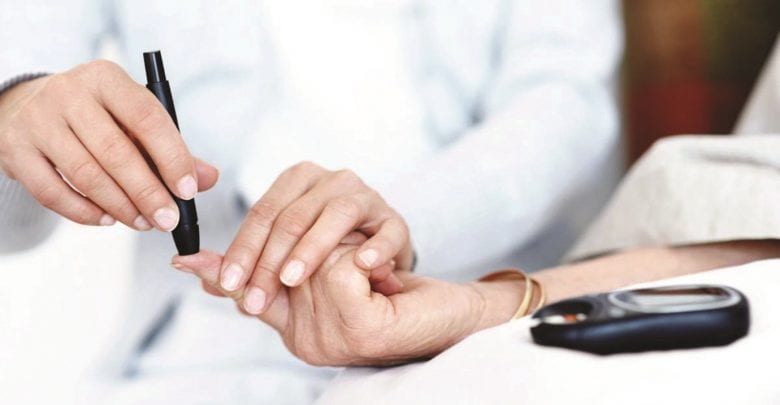
Researchers develop wearable technology for diabetics
أدوات وقائية مبتكرة لـ «تقرحات السكري»
A collaborative research project bringing together four separate studies by researchers at Hamad Medical Corporation (HMC), in partnership with Qatar Foundation and several institutions in the US, has led to the development of innovative, wearable devices that could enhance the prevention, management and treatment of diabetic foot ulcers.
The studies, completed over a 10-year period, won the Best Research Project Award at Qatar Foundation’s Annual Research Conference earlier this year, HMC said in a statement yesterday.
HMC’s podiatry clinics treat thousands of patients with diabetes each year, with nearly 15,000 diabetes-related appointments in 2017 alone. The International Diabetes Federation estimates that around 23% of Qatar’s population has diabetes, with diabetic foot ulcers being the main reason for hospitalisation for people with diabetes.
“Between 10% and 20% of people with diabetes will develop a foot ulcer at some point in their life,” explained Dr Talal Khader Talal, head of Podiatric Services at HMC and a lead author of the studies.
“People with diabetes are especially vulnerable to foot ulcers as their blood sugar levels are often high and can fluctuate. This can inhibit the skin’s ability to repair itself due to nerve damage. Due to a condition called peripheral diabetic neuropathy, many diabetics have reduced nerve function and sensation in their feet, meaning they may be unaware of cuts, damage, and ulcers on their feet until they become severe,” added Dr Talal.
One of the research studies led to the development of a specialist ‘smart sock’, which enables clinical teams to monitor the temperature, pressure and joint angles of a patient’s feet via fibre optic sensors. The information is sent automatically to a specialised device and can be viewed by both the patient and their doctor.
“By monitoring this information via the ‘smart sock’, we are able to predict when a patient may be most vulnerable to the development of a foot ulcer. We are then able to help the patient change their behaviour and minimise this risk,” said Dr Talal.
In another of the studies, the researchers designed a specialist shirt capable of monitoring patients’ activity. Physical activity is an important component of managing diabetes but it can be challenging to get the right balance; high levels of activity can cause stress and pressure on the feet, while low activity levels may increase the risk of foot ulcers.
“Our research also focused on enhancing the treatment of diabetic foot ulcers and one of the studies led to the development of wearable units, which can be used to send electro impulses to the feet to stimulate blood flow and increase healing. In addition to the positive healing effect, the impulses are also able to increase sensation in the feet,’’ noted Dr Talal.
The final study looked at the effect of sensor-based interactive balance training. Due to the loss of feeling in their feet, some patients with diabetes experience mobility issues and lose confidence. The interactive balance training used sensors and a computer-based avatar, which navigated obstacles. This provided a safe way for these patients to gain confidence in their mobility.
“Though the devices developed are still undergoing further investigation, our initial research findings indicate that they could become very valuable tools in the future and boost our ability to prevent, manage and treat diabetic foot ulcers,” added Dr Talal.
أسفر مشروع بحثي مشترك -ضمّ 4 دراسات منفصلة، أجراها باحثون من مؤسسة حمد الطبية، بالتعاون مع مؤسسة قطر للتربية والعلوم وتنمية المجتمع، وبعض المؤسسات البحثية في الولايات المتحدة الأميركية- عن تطوير مجموعة من الأدوات المبتكرة تتيح لمرضى السكري ارتداءها، وتقيهم في الوقت نفسه من تقرّحات القدم (القدم السكّرية)، وتفيد كذلك في معالجة هذه التقرحات عند الإصابة بها.
أشار الدكتور طلال خضر طلال -رئيس قسم العناية بالقدم في مؤسسة حمد الطبية، أحد قادة الدراسات البحثية في مجال مرض السكري- إلى أن 10-20 % من مرضى السكري، أكثر عرضة للإصابة بتقرّحات القدم في مرحلة ما من حياتهم. وأضاف : « نظراً لإصابتهم باعتلال الأعصاب المحيطية، فإن مرضى السكري يفقدون النشاط العصبي الحسّي ، الأمر الذي يجعلهم لا يحسّون بجروح وتقرحات القدم التي قد يتعرضون لها، إلا عندما تتفاقم ويصبح علاجها صعباً».
وذكر أن إحدى الدراسات البحثية، قد أفضت إلى تطوير ما يسمى بالجوارب الذكية المصممة للارتداء من قِبل مريض السكري، والتي تمكّن الفرق الطبية من مراقبة درجة الحرارة، وضغط الدم، والزوايا الموقعية للمفاصل في قدم المريض، وذلك عبر حسّاسات من الألياف البصرية تشتمل عليها هذه الجوارب، موضحاً أنه يتم إرسال هذه البيانات تلقائياً إلى جهاز خاص يمكن لكل من الطبيب والمريض الاطلاع على القراءات التي يتم تخزينها فيه.
وقال إنه من خلال مراقبة هذه البيانات عبر الجوارب الذكية، يمكن التنبّؤ بما ستتعرّض له قدم المريض من تقرّحات في المستقبل، وبالتالي التمكن من مساعدة المريض في تغيير سلوكه أو نمط حياته.
كما تمخّضت إحدى الدراسات البحثية -التي تم إجراؤها- عن اختراع وتطوير قميص يرتديه مريض السكري، يقوم بمراقبة وقياس النشاط البدني لديه، باعتبار أن هذا النشاط يعدّ أحد أهم أركان معالجة مرض السكري والتعايش معه.
وقال الدكتور طلال: «تركزت مشاريعنا البحثية حول تعزيز الأساليب العلاجية لتقرّحات القدم، حيث نتج عن إحدى هذه الدراسات ابتكار بعض الأجهزة والأدوات التي يمكن ارتداؤها من قِبل مريض السكري، وتقوم بإرسال نبضات كهربائية إلى القدمين لزيادة تدفّق الدم في القدمين، وبالتالي المساعدة في التئام تقرّحات القدمين».
ونوه بأن الدراسة الأخيرة، تناولت بحث الأثر التدريبي على نظم التوازن الحركي التفاعلي المعززة بالحسّاسات، موضحاً أنه نظراً لفقدان بعض مرضى السكري للإحساس في القدمين، فإنهم يواجهون بعض المشاكل الحركية، وقال إنه استحداث نظم التوازن الحركي التفاعلي المعززة بالحسّاسات لمساعدة المرضى على تخطّي العقبات، واستعادة الثقة في أنفسهم في الحركة بصورة آمنة.;



